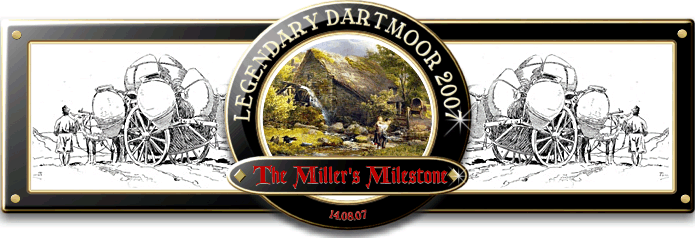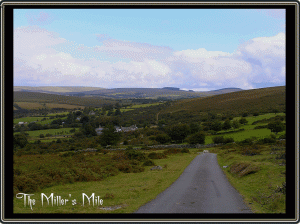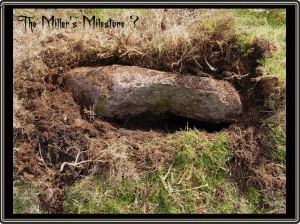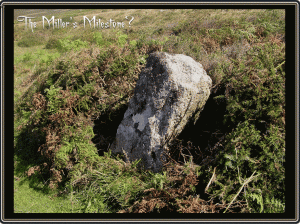
“A wagon gay and horses four,
Are standing here against your door,
Five-and-twenty sacks of corn,
Waiting to be upward bourn.”
This is not a story about gruesome happenings at an ancient stone or of merrymakers being petrified for enjoying themselves on the Sabbath. This is all about what can only be described as a pathetic, unmarked slab of granite that has lain by the side of a small road for centuries. In the great scheme of things the Miller’s Milestone hardly made a ripple on the pond of life except that is if you were a packhorse laden with sacks of flour you were mighty glad to see it. Today the sorry milestone lays prone on the roadside, forgotten and forlorn, unable to tell its quirky history and raison d’être.
The Miller’s Milestone marks amazingly enough the end of the Miller’s Mile and that is the distance from the one-time corn mill that was at Babeny. It is at this point that the steep road leading up from the mill begins to level out and in olden times it was here that the farmers and pack-horse men would mount their ponies. The ascent from the mill was far too long and steep for the ponies to carry a full load of flour and a man so some consideration was shown to the animal. The thing I can never understand is that both the pack-horse men and the farmers knew the capabilities of their animals only too well and they would have known the moors like the back of their hands. So why did they need a marker stone to indicate when the steep hill was levelling out, surely that was blatantly obvious? Either way the Miller’s Milestone once stood and now lays for eternity. As to when it was first erected is anyone’s guess but the old mill at Babeny dates back to 1302/3 and ceased working in the mid 1800s, as can be seen from the 1888 OS map. When first built the mill would have provided a wealthy income for the Duchy as it was where the inhabitants of the Forest of Dartmoor were obliged to bring their corn to be milled. In 1303 it is documented that the rents due to the Crown for the mill were 4 shillings which today would be about £90 in today’s money. As with most mills on Dartmoor it was powered by a water wheel supplied by a very early leat.
Just adjacent and northwards of the milestone is a group of rocks which admirably represent the fascination of the origins of place-names because they are called ‘Flour Rocks’. Logically one would surmise that the name refers to the fact that they possibly resemble sacks of flour or that possibly the site was where flour sacks were stacked. But this is Dartmoor and as always nothing is that simple, the name comes from the fact that a wagon or cart carrying lour up from the mill overturned near to the rocks. As the load spilled onto the track some of the sacks burst and the flour coated the rocks thus giving them a white hue for several weeks, hence – Flour Rocks.
Having described the milestone and the rocks I decided to go out there and get some photographs which hopefully I have. There are two descriptions of the location of the milestone, one says it is just down from the Cave Penney memorial, the other that it is lying down under vegetation exactly a mile from the mill. Well the hunt began and as Dartmoor is not short of rocks three likely candidates came forward which proved a dilemma. They were about 500 yards apart and all looked like possible milestones, two were prone and one was still standing. The only way to sort it was to drive down to the mill, put the trip on and measure one mile which ended up at the higher of the three stones, just down from the Cave Penney memorial and can be seen in the photograph. This then made Flour Rocks the small group of boulders just north of the milestone and on the opposite side of the lane, again there were two possible contenders.
It may seem that there is not much to get enthralled about when looking at the Miller’s Milestone, so why bother with writing about it? Well, sometimes it’s nice to sit quietly on the moor and try to imagine what it was like in olden times and this is such a spot where your imagination can run wild. Pick an early morning or a late evening and sit on the crest of the hill. look out over the ancient tenements below and picture a laden pack-horse struggling up the hill. On its back are sacks of freshly milled flour, one of which must have a small hole in it as there is a tiny dusty cloud following in the animals wake. In the distance you can faintly hear the rhythmic rolling of the millstones and clatter of the mill wheel as it slowly turns on its squeaky axle. Dogs bark in the yard as another pack-horse arrives to collect its burden of flour, the miller’s wife yells at the yapping canines and the men begin to load the sacks. The man leading his load up the hill finally reaches the milestone and with a steadying, “whoa bouy”, thankfully clambers onto the animals back. He pulls out a crumpled, spotted kerchief and wipes his sweating brow, the pony snorts and stamps a hoof which encourages a fine white cloud of flour to puff out of one of the sacks. The air is heavy with the pungent smell of equine sweat and leather and high above this scene trills a skylark. With a gentle slap on the ponies neck both beast and master slowly clop off down the road, a haze of flies scatter from around the pony’s back as it angrily swishes its tail. A feint trickle of flour leaves a snaking trail of fresh white powder on the rocky surface of the track for all to follow. As the laden pony disappears over the horizon it gives a disgusted snort because it knows that very shortly there will be an ever steeper ascent up to Huccaby.
“I hear the water music still,
That babbles underneath the mill:
The breast wheel’s lapping intervenes,
And rumbling of the mill machine”.
Maybe it would be a nice idea for one of the caring, sharing Dartmoor societies to part with some funds and have the stone re-erected for all to see, afterall there has been a lot of fuss made about the ‘Take Off Stone‘ and that served the same kind of purpose.
In the area of the Miller’s Milestone are several other ‘legendary’ places such as; The Monument, the Money Pit, the Cave-Penney Memorial, Sherwell the old haunt of Martha Whitchalse, the Coffin Stone and Dartmeet.
 Legendary Dartmoor The many aspects past and present of Dartmoor
Legendary Dartmoor The many aspects past and present of Dartmoor



